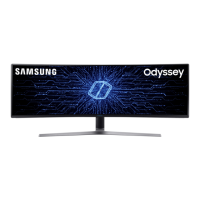
Do you have a question about the Samsung C49HG90DM Series and is the answer not in the manual?
| Style | Curved |
|---|---|
| Color | Middle : Silver spray |
| Screen Type | QLED |
| Stand Type | HAS |
| Wall Mount | 100 mm x 100 mm |
| Tilt | -2.0° (±2.0°) ~ +15.0° (±2.0°) |
| Sound | - |
| Features | Built-In DTV Tuner With PiP |
| OS Compatibility | Mac |
| Interface Connectors | Audio Out |
| Operation Conditions | - |
| Tiltable | yes |
| Touch Screen | no |
| Webcam | no |
| Screen Size | 49 |
| Panel Type | VA |
| Aspect Ratio | 32:9 |
| Resolution | 3840X1080 |
| Refresh Rate | 144 Hz |
| Viewing Angle | 178°/ 178° |
| Response Time | 1 (MPRT) ms |
| Brightness | 250 Nit |
| Contrast Ratio | 3000:1 |
| Pixel Pitch | - |
| Native Resolution | 3840 x 1080 |
| Horizontal Viewing Angle | 178 degrees |
| Vertical Viewing Angle | 178 degrees |
| Synchronization | freesync (amd adaptive sync) |
| HDR | yes |
| HDR Format | vesa certified displayhdr 600 |
| Type | Internal Power |
| Power Supply | 100~240V |
| Power Consumption | 0.3 W (off mode) |
| Depth with Stand | 381.6 mm |
| Height with Stand | 525.5 mm |
| Width with Stand | 1203.0 mm |
| Net Weight with Stand | 16 kg |
| Depth without Stand | 194.4 mm |
| Height without Stand | 369.4 mm |
| Width without Stand | 1203.0 mm |
| Net Weight without Stand | - |
| Built-In Speakers | no |
| HDMI Ports | 2 |
| USB Ports | 2 x usb-a 3.0 |
| Display Port Inputs | 1 |
| Mini Display Port | 1 |
| DVI | 0 |
| Headphones Output | yes |
| Voice Assistant | no |
| Power Saving Mode | 0.3 watts |
Guidance on ventilation space, storage, and potential staining from humidifiers.
Instructions for cleaning the monitor and safety guidelines for power connections.
Warnings and cautions for safe product installation environments and locations.
Key warnings for safe operation, handling, and environmental factors.
Cautions on screen burn-in, eyesight, and recommendations for correct posture.
Identifies physical parts and explains control panel functions for navigation.
Introduction to using shortcut keys for custom game modes.
Explains OSD menu navigation using function keys and icons.
Details JOG button usage for different modes and accessing saved game settings.
How to adjust brightness, contrast, sharpness, and volume using the JOG button.
Diagram and description of all ports located on the reverse side of the monitor.
Step-by-step guide for updating the monitor's software using a USB drive.
Important notes on supported USB formats, naming rules, and error handling for upgrades.
Instructions on how to adjust the monitor's physical tilt and height.
Guide on how to use an anti-theft locking device for security.
Detailed assembly instructions for the Type one monitor stand.
Detailed assembly instructions for the Type two monitor stand.
Instructions for detaching the monitor stand for wall mounting.
Steps for securely mounting the monitor to a wall using a bracket.
Essential checks before connecting devices and guides for PC connection via HDMI/DP.
Instructions for connecting via Mini DP, headphones, and microphone.
How the monitor functions as a USB hub and connects to a PC.
Instructions for connecting the monitor to a power outlet.
Guide on organizing cables using the provided hangers and holders.
Recommendations for correct posture and installing necessary monitor drivers.
Information on setting the optimal resolution and frequency for the monitor.
Explains different Picture Modes for optimal gaming environments.
How to adjust refresh rate, response time, and black equalizer for gaming.
Details FreeSync for smooth gameplay and how to enable it.
Lists compatible graphics cards and how to minimize input lag.
Options for selecting the best screen size and aspect ratio.
Screen size options in AV mode and how to save custom game settings.
Comprehensive explanation of various Picture Modes for different uses.
How to adjust brightness, contrast, sharpness, and color parameters.
Adjustments for HDMI black level, screen positioning, and eye comfort.
Explains Picture-by-Picture (PBP) settings and how to enable/disable PBP mode.
How to set aspect ratios and select input sources for PBP screens.
How to set the OSD menu language and its display duration.
Configuration of LED lighting, local dimming, and volume control.
Settings for power saving, PC/AV mode, and automatic power-off timer.
How to utilize USB ports for fast charging of connected devices.
Settings for DisplayPort version, HDMI mode, source detection, and key repeat time.
Configuration of the power LED indicator and resetting all settings.
Viewing system information and understanding the HDR feature.
Requirements and conditions necessary to enable and use HDR effects.
Guide to installing Easy Setting Box software, including system requirements and potential issues.
Steps before contacting support and troubleshooting PC installation problems.
Troubleshooting common screen display and power indicator issues.
Solutions for distorted, blurry, unstable, or color-inconsistent screen images.
Troubleshooting for power saving mode, blurry text, and choppy video playback.
How to resolve sound problems and unexpected beeping from source devices.
Frequently asked questions about changing frequency, resolution, and power-saving modes.
Overview of the monitor's general specifications, including size and connectors.
Table listing standard signal modes, resolutions, and frequencies for compatibility.
Detailed table of resolutions, horizontal/vertical frequencies, and pixel clocks.
Details on pay service conditions, non-defects, and customer-caused damages.
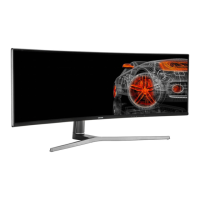

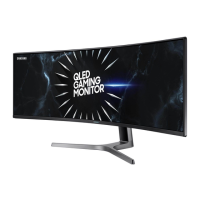
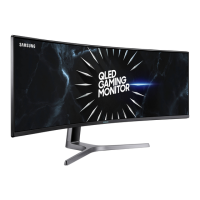
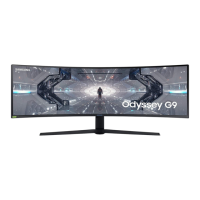
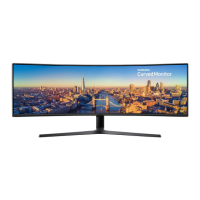
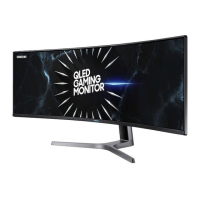
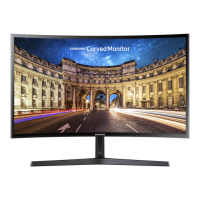

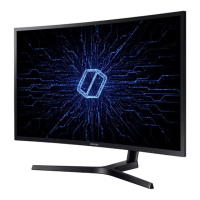
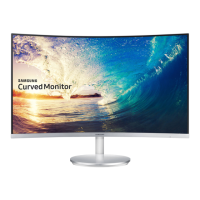

